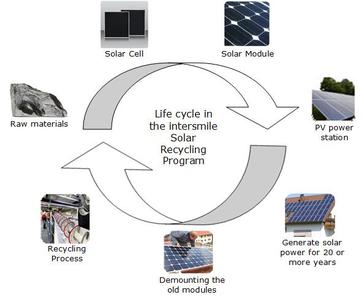Photovoltaics
The most commonly used photovoltaics consist of monocrystalline or multicrystalline silicon. The main negative environmental impact of these panels comes from the production phase and include:
The environmentally relevant substances released during the production phase of silicon solar panels are fluorine, chlorine, nitrate, isopropanol, SO2, CO2 and respirable silica particles and solvents [19].
However, over the course of their lifetime, crystalline solar panels generate 9-17 times the energy used to produce them, depending on their placement and efficiency. Also, depending on the type of PV technology, the clean energy pay back takes place in one to four years [18]. Once in place, solar systems using photovoltaics are 100% emissions free. The production of 1,000 kWh of solar electricity reduces emissions by nearly 8 pounds of sulfur dioxide, 5 pounds of nitrogen oxides, and more than 1,400 pounds of carbon dioxide [18].
Most silicon solar panels have a lifespan of around 25-30 years, and there are currently no commercially available recycling technologies available for the panels. However, according to the European Photovoltaic Industry Association, it will only take 1/3 the energy to make solar panels from recycled ones, rather than using new materials [18].
- The energy consumed during production of the panels and the emissions released during production
- Water consumption
- The release of some hazardous byproducts [18].
The environmentally relevant substances released during the production phase of silicon solar panels are fluorine, chlorine, nitrate, isopropanol, SO2, CO2 and respirable silica particles and solvents [19].
However, over the course of their lifetime, crystalline solar panels generate 9-17 times the energy used to produce them, depending on their placement and efficiency. Also, depending on the type of PV technology, the clean energy pay back takes place in one to four years [18]. Once in place, solar systems using photovoltaics are 100% emissions free. The production of 1,000 kWh of solar electricity reduces emissions by nearly 8 pounds of sulfur dioxide, 5 pounds of nitrogen oxides, and more than 1,400 pounds of carbon dioxide [18].
Most silicon solar panels have a lifespan of around 25-30 years, and there are currently no commercially available recycling technologies available for the panels. However, according to the European Photovoltaic Industry Association, it will only take 1/3 the energy to make solar panels from recycled ones, rather than using new materials [18].
Concentrating Solar Power
Although the construction of solar thermal electricity facilities results in disruption and damage to local environments, this is still a very efficient form of renewable energy. Compared to the life-cycle of a coal plant that produces 1000 g CO2/kWh, concentrating solar power only produces around 20 g CO2/kWh over the course of its life. The total lifecycle greenhouse gas emissions from CSP are comparable to other renewables such as nuclear power [20].
One of the main advantages of CSP over PV is that it is 3 to 7 times more efficient at converting solar radiation into a usable form of energy because sunlight can be more readily converted into heat than electricity. Therefore, although CSP requires more energy during its construction, its payback takes place much quicker than for PV systems [21].
One of the main advantages of CSP over PV is that it is 3 to 7 times more efficient at converting solar radiation into a usable form of energy because sunlight can be more readily converted into heat than electricity. Therefore, although CSP requires more energy during its construction, its payback takes place much quicker than for PV systems [21].

